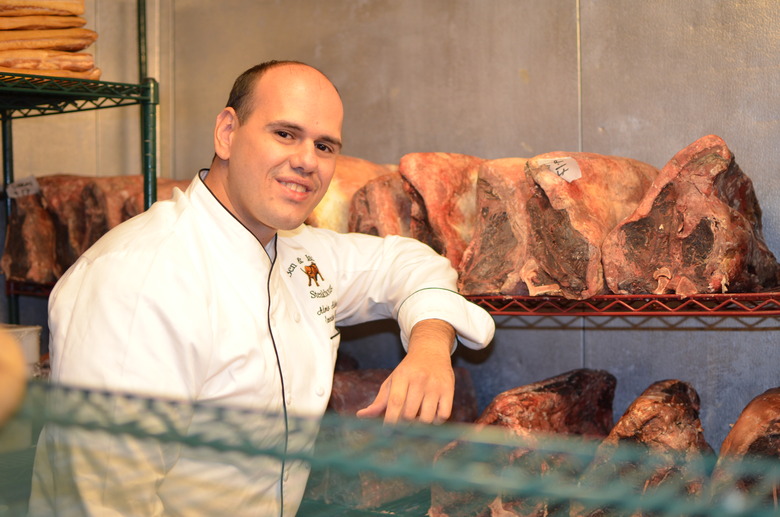A Food Scientist's Lab Is His Kitchen At New York's Ben & Jack's Steakhouse
One might wonder just how to make use of a food science degree at somewhere as simple and classic as a New York Steakhouse.
Well, wonder no more. Ben & Jack's Steakhouse's executive chef Admir Alibasic is about to blow your mind with what's fact and what's fiction in the world of aging meat. Just read on.
Daily Meal: What do you think sets Ben & Jack's apart from all of the other steakhouses in NYC?
Chef Admir Alibasic: With all of these steakhouses popping up on every corner in Manhattan, you have to focus on consistency in addition to providing the finest quality of meat. We take our dry-aging process very seriously and have constructed an aging box that is perfect down to the molecular level. It is a process whereby beef carcasses are stored – without protective packaging – at refrigeration temperatures for one to five weeks to allow the natural enzymatic and biochemical processes that result in improved tenderness and the development of the unique flavor that can only be captured by this process.
Tell me about your background with Ben and Jack's...
When Ben & Jack's Steak House first opened, my uncle Harry Sinanaj knew my passion for food and experimentation and approached me and said, "Hey, would you like to work in the kitchen?" I quickly accepted the offer thinking, "How hard could it be?" Little did I know, it wasn't easy working in a commercial kitchen because the action never stops. Literally, you need to keep your eyes and ears alert at all times.
Did you graduate college or go straight into the restaurant business?
Yes, I worked in the restaurant and went to school full time at Hunter College, pursuing a Bachelor's degree in Food Science. This degree provided me with a fresh outlook of how chemical elements group together to create something as complex as oil. This education further inspired me to incorporate the science behind food, perfecting the art of dry-aging and adding more unique twists and ingredients to unorthodox dishes.
How do you manage to find ways to apply your food science background working somewhere as traditional as a steakhouse?
Yes, it is a traditional steakhouse, but the secret is in the dry-aging. From bacterial growth to relative humidity, there is a lot of science that goes into the aging process. For instance, there is a mold that grows on the surface of the meat after the third week of aging (if all goes well) that helps tenderize the meat by breaking down the connective tissues and muscle. Thus, fat oxidation occurs.
Once the fat starts to oxidize, it causes many chemical reactions that create unique flavors similar to a funky, almost blue cheese-like aroma to the meat. The outer layers are then carved off and discarded before being sold, leaving you with clean, flavorful, ulta-tender meat underneath. During the dry-aging process, the marbling does not increase yet due to dehydration; the fat molecules get denser which actually increase the surface area of marbling. The amount of fat remains the same. The process is not cheap, but in my opinion, the results are well worth the extra cost.
Do you do anything more creative on the side?
I do compete in several food competitions that require me to transform a single ingredient and make it the star of the dish. For instance, during Avocado Madness, I developed avocado-inspired recipes and competed against a line-up of 64 chefs. Some of the dishes I created include: lamb taco with grilled mango tzatziki and hummus guacamole and fried shrimp po'boy with avocado mayo cole slaw and avocado fries, to name a few. Similarly, I also placed in the Final 50 Short-List out of 380 entries for the Barilla "Represent Your Region" Contest, where I designed a recipe for a 40 day Dry-Aged NY Strip with Bucatini, Shiitake Mushrooms, and Sun Dried Tomatoes.
What's on the horizon for you this summer?
I will be competing in Dan's Grill Hampton event in July, NYC vs. The Hamptons: The Fiercest Culinary Battle of Summer. In fact, I'll be one of the featured chefs on the New York City team that will be competing against the East End chefs in a one-of-a-kind cooking competition. A portion of this year's ticket proceeds will benefit All For The East End, a nonprofit that provides support to over 1,000 charity organizations in the five East End towns.
Do you do any other charity work?
I've cooked for groups as large as 4,000 attendees and utilize my skills where needed. Some of the charities we have worked with include: American Cancer Society, City Harvest, Sarcoma Foundation, St. Judes, Boys and Girls Club, Food Bank, (RED), and many more. While doing these charity events, I meet new people that have the same underlying passion as I do. I've learned that you need to appreciate what you have in life and at the same time, if you can help make a difference, do it!
Got anything else fun cooking for this summer?
I'm participating in the Food Network's Rooftop Chopped Walk Around Tasting event at Pier 92 in NYC, where I'll compete alongside various cast members from the show including Ted Allen, Scott Conant, Alex Guarnaschelli, Marc Murphy, Marcus Samuelsson, and Geoffrey Zakarian. Each guest will have the opportunity to vote for their favorite bites of the night to determine whose dish shines the brightest and whose dish will be on the chopping block!
